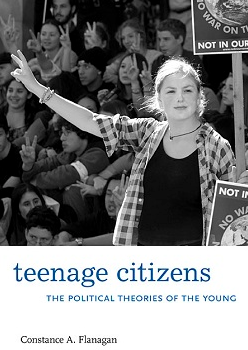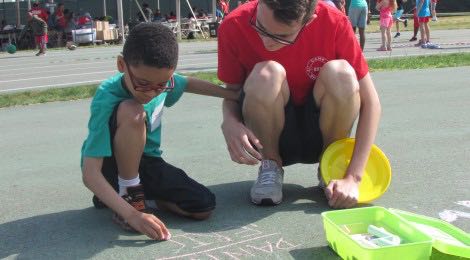New study explores how teenagers understand inequality
 By Connie Flanagan (originally posted at http://wtgrantfoundation.org/)
By Connie Flanagan (originally posted at http://wtgrantfoundation.org/)
Young people’s ideas about economic inequality have received scant attention in research despite the fact that we now have several generations for whom an unequal society with an eroding safety net is the world they’ve known.
To gain some insights into teenagers’ theories about inequality, my colleagues and I posed the following question to nearly 600 middle- and high-school students from different racial and ethnic backgrounds who attended schools in low-, middle-, and high-income communities:
“Imagine that someone from another country were visiting the United States and they asked you to explain some things to them. Suppose they asked you to explain why some people in the United States are poor and why some people are rich, what would you say?”
We coded the teens’ explanations for references to individual (motivation, hard work); structural (few job training programs; cost of housing); and uncontrollable (bad or good luck) factors. We calculated the number of reasons each student gave and whether s/he mentioned different causes. What did we learn?
First, adolescents knew more about ways that people might become rich than ways they might become poor, in terms of the sheer number and the different routes. For example, people might be poor because they “did not have the will power to get a good job,” whereas they might be rich because they “had a good education, confidence, family wealth or inheritance, worked hard.”
Second, there was a sense that the rich had earned their status, but not a similar sense that the poor should unequivocally be blamed for theirs. Whereas teens tended to give credit to the wealthy for working hard, they were as likely to mention a structural as an individual attribution to explain why people might be poor. Rich people “finished school and took care of what they had to do; they had a goal and reached it.” Poor people “might not have ambition and the companies have taken jobs overseas.”
Third, theories about inequality were internally consistent for over half of the young people. That is, they either mentioned individual or structural causes for both poverty and wealth. The former group might note that rich people worked hard and poor people were lazy. The latter group reasoned that people might be poor because “Everyone is competing and there are not enough jobs to go around,” “Those with less education and training get shut out,” and that rich people may have “inherited their money or they have great connections, or they’re drug dealers.”
“…the freedom to criticize the system reflects, in part, the safety net of privilege.”
For the other half of the respondents, explanations for poverty invoked different underlying causes than those for wealth. People were poor because they “don’t have jobs and sometimes jobs can be hard to find and you cannot have a house with only making $4.25 per hour and having kids,” whereas people who were rich “set a goal for themselves, studied hard and got a good job”.
What might account for differences in teens’ theories about inequality? Not surprisingly, older adolescents knew more about causes, including structural ones. But it was the social class differences in explaining inequality that gave us pause. Youth in better-educated families and higher income communities knew more about factors underlying inequality and also were more likely to mention the structural roots of poverty. This was explained by the fact that their families discussed current events and politics and that their classmates’ families also engaged in such discussions. In contrast, it was adolescents in the least privileged circumstances (whose parents had lower levels of education, whose schools were located in low-income communities, and whose classmates reported few discussions of current events at home) who were more likely to admire the wealthy for making it and contend that people were poor because they lacked motivation or hadn’t applied themselves in school. In fact, the connection between working hard in school and succeeding in life was palpable:
The reason why people have good jobs is because they work for 17–20 years in school,” whereas the poor “chose that lifestyle when they did not take school seriously.”
How should we interpret these findings? One answer is that they reflect differences in opportunities to learn about society that accrue to youth from different social classes. Another is that they reflect the distinct realities that an unequal society with a shredded safety net portends for different groups of young people. It may be easier to attend to the structural roots of inequality from a position of advantage since one’s own group is less likely to suffer the consequences of an unequal system. In other words, the freedom to criticize the system reflects, in part, the safety net of privilege.
In contrast, for those youth who remain in schools where half of their classmates will drop out, an ardent commitment to self-reliance and a belief in the efficacy of individual effort may keep them going. The imperative of self-reliance and the lack of safety nets also seem to be messages that they hear at home: it was youth in the least privileged families who were most likely to report that their parents admonished them that they should work twice as hard as others if they wanted to get a job; that people have to create their own opportunities since nobody hands them to you; that they couldn’t blame others for their problems; and that if they didn’t succeed in life, they would have only themselves to blame.
The notion that we live in a meritocracy is a lesson that most children in the United States learn as they grow up. But it may be even more incumbent on youth who have few connections, safety nets, or second chances to embrace that belief. How else can they hope to attain the American dream?
Connie Flanagan is a Professor, Department of Interdisciplinary Studies in the School of Human Ecology at the University of Wisconsin-Madison










